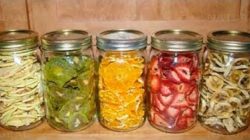Canning and Preserving Tips and Tricks
Wouldn’t it be nice to have a pantry and freezer stocked with plenty of fresh, homegrown foods as a buffer against food shortages and high prices this winter? If you’re new to canning and preserving food – like some of us – here’s an easy primer about how to preserve the veggies and fruit you’re growing or getting from the weekly Farmer’s Market.
So You Want to Can Veggies…
 Canning is the process of preserving a food by heating it to a high enough temperature to kill any harmful bacteria and then sealing it in an airtight container for storage. Canning is preferred by some because it preserves the food’s color, flavor and texture and some of its nutrients. It also can take less time than dehydrating but the jars of food are heavy and take up more shelf space than dehydrated foods. Another potential problem is the risk of food spoilage if the canning process steps are not carefully followed.
Canning is the process of preserving a food by heating it to a high enough temperature to kill any harmful bacteria and then sealing it in an airtight container for storage. Canning is preferred by some because it preserves the food’s color, flavor and texture and some of its nutrients. It also can take less time than dehydrating but the jars of food are heavy and take up more shelf space than dehydrated foods. Another potential problem is the risk of food spoilage if the canning process steps are not carefully followed.
 To feel confident about prepping safe canned (or jarred!) goods, take a look at the two methods approved by the USDA at the Dummies.com website.
To feel confident about prepping safe canned (or jarred!) goods, take a look at the two methods approved by the USDA at the Dummies.com website.
Some of the telltale signs of spoilage are:
- Bulging or loosened lids on canned jars
- Weeping or leakage from under a previously sealed jar
- Bubbly or foamy contents of canned food
- Visible mold or mildew on the lid, inside the jar, or on the food itself
Water Bath vs. Pressure Canning
 Water-bath canning, aka hot water canning, uses a big kettle of boiling water. Once food jars are filled, they’re submerged and boiled at 212 degrees for a period of time. This is the method used to process foods with high-acid content, like tomatoes, fruit, pickles and pickled veggies.
Water-bath canning, aka hot water canning, uses a big kettle of boiling water. Once food jars are filled, they’re submerged and boiled at 212 degrees for a period of time. This is the method used to process foods with high-acid content, like tomatoes, fruit, pickles and pickled veggies.
Pressure canning uses a large kettle to produce steam inside the filled and sealed jars at a temperature of 240 degrees. Pressure canning is the method used to process vegetables and other low-acid foods like meat, fish and poultry. Just follow the instructions to the letter.
For a few canning and pickling recipes, head over to Cooking Light where you’ll find how-to tips and ideas for pickling everything from asparagus and zucchini, to turnips, green beans and beets.
Freezing and Drying Food
 You can also freeze, smoke, dry, juice and ferment foods. Some people prefer drying or dehydrating foods because it’s an easy process and can be done using the oven or a dehydrator. Fewer nutrients are lost (three to five percent vs. canning’s 60 to 80 percent) and the risk of botulism is a lot lower.
You can also freeze, smoke, dry, juice and ferment foods. Some people prefer drying or dehydrating foods because it’s an easy process and can be done using the oven or a dehydrator. Fewer nutrients are lost (three to five percent vs. canning’s 60 to 80 percent) and the risk of botulism is a lot lower.
To freeze, watch this video from The Spruce about preserving broccoli. After cutting, blanching, a cold-bath rinse and dry, the broccoli is ready for bagging and should be good for one year frozen.
On the drying side, veggies, fruits, seeds, jerky, leather, and even popcorn can be dehydrated. Mary’s Nest on YouTube will show you how to dry apples, and give you tips about which apples are best for chips, and which are best for rings – when to leave the skin on and when to peel them.
After experimenting for three days, Amy Family DIY came up with a few minutes worth of secrets for drying citrus: oranges, grapefruit, lemons and limes, but for a definitive beginners’ guide to dehydrating ALL sorts of food, head over Fresh Off the Grid.
Recipes for Rehydrated Foods
You’ll find everything you need to know about preserving food, from fruits and vegetables to grains and herbs including instructional tips about safe handling techniques, storage and shelf life expectancies and even how to rehydrate food in the field with a slew of “backcountry recipes”!
And if you’d rather watch than read, set aside 15 minutes to view Linda’s tutorial with a how-to dehydrate garlic and kale and rehydrate for a taste test!
The whole idea of canning and preserving is to take advantage of fresh food — full of flavor and nutrition — when it’s abundant and less costly. And in the interests of those who love peaches and/or figs, we leave you with this instant pot recipe for jam from Texas Monthly. All it takes to create peach preserves to slather on your bread and biscuits is some tasty ripe peaches, sugar, vanilla, a pinch of salt and a little lemon juice. So easy!
Farmer’s Market in Colliers Hill
 Local farmers will supply you with some of the freshest produce on the planet every Thursday at 5:00 p.m. in downtown Erie at Briggs Street, between Wells and Moffatt. And if you don’t live here yet, check out the many amenities in the master-planned community of Colliers Hill, and the beautiful model homes from Richmond American Homes and Century Communities – and coming this winter – K B Home — paired offerings. It’s a great time to buy with rates so low – and lots of possibilities from the high $300s.
Local farmers will supply you with some of the freshest produce on the planet every Thursday at 5:00 p.m. in downtown Erie at Briggs Street, between Wells and Moffatt. And if you don’t live here yet, check out the many amenities in the master-planned community of Colliers Hill, and the beautiful model homes from Richmond American Homes and Century Communities – and coming this winter – K B Home — paired offerings. It’s a great time to buy with rates so low – and lots of possibilities from the high $300s.


